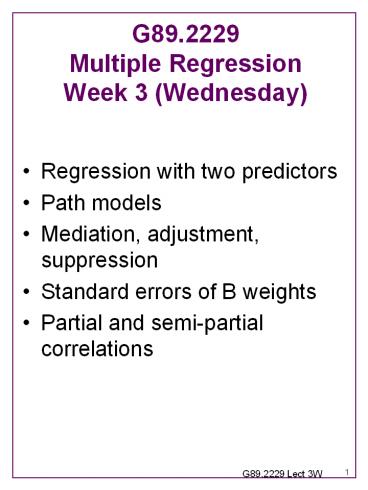Regression with two predictors PowerPoint PPT Presentation
1 / 12
Title: Regression with two predictors
1
G89.2229 Multiple Regression Week 3 (Wednesday)
- Regression with two predictors
- Path models
- Mediation, adjustment, suppression
- Standard errors of B weights
- Partial and semi-partial correlations
2
The geometry of E(YX1 X2) b0 b1X1 b2X2
- E(YX1 X2) b0 b1X1 b2X2 describes a plane.
- For every change in either X1 or X2, E(YX1 X2)
changes linearly - The distribution of X1 and X2 does not affect the
form of the plane itself, but it does affect the
estimates of b0, b1, and b2. - MOST IMPORTANTLY, The distribution of X1 and X2
has a profound effect on how the semipartial
effects, b0, b1, and b2 relate to bivariate
correlations.
3
When X1 and X2 are uncorrelated
- In experiments, we manipulate X1 and X2 so that
they are balanced, and uncorrelated - X1 and X2 are said to be "orthogonal"
- When X1 and X2 are orthogonal the semipartial
effects are identical to the bivariate effects of
X1 or X2 on Y
X2
X1
4
When X1 and X2 are correlated
- In surveys we usually observe X1 and X2 without
adjusting their relative frequency - As an exception, sometimes we oversample certain
rare values - When X1 and X2 are correlated the semipartial
effects are different from the bivariate effects
of X1 or X2 on Y
5
Path models
- A useful way to think about regression models is
through path diagrams. - Y a bX e
e
b
X
Y
Y B0 B1X1 B2X2 e
6
Mediation Model
- Suppose we have an association between X and
YThat we believe is mediated by a variable M
The indirect effect of X on Y through M is ab.
If c' is zero, complete mediation is suggested.
If c' is less than c, then partial mediation is
suggested.
7
Two equations for Mediation Model
- M a0 aX eM
- Y b0 bM c'X eY
- When M in the second is replaced with M in the
first, we see where the multiplicative path comes
from. - Special path terms
- M and Y are endogenous
- X is exogenous
8
Example of Mediation
- Suppose that X is time spent studying for GRE
verbal test. - Suppose Y is the Verbal GRE score.
- Suppose M is the number of new vocabulary words
learned. - A pattern of complete mediation would follow from
the following correlations - r(XY) .35
- r(XM) .70
- r(MY) .50
- See Shrout and Bolger (2002) for other examples.
9
Algebraic thinking about semipartial coefficients
- The OLS estimates of B0, B1 and B2 are those
numbers which make the sum of the squared E terms
as small as possible. - Some math yields the following
- The factor to the right is the standardized
coefficient - The numerator of that factor shows the adjustment
for the second variable.
10
To Test B estimate with Wald statistic
- Compute standard error of Bi and compute Wald
Statistic - Divide Bi by the square root of this variance
- Under the null hypothesis, H0Bi0, this
statistic has a central t distribution on (n-3)
degrees of freedom - The same standard error can be used to compute
symmetric confidence bound - Bj (sej)(t.5a)
11
Suppression
- Sometimes the semipartial effect for X1 (i.e. b1)
inY b0 b1X1 b2X2 eis larger in absolute
magnitude than the bivariate effect inY b0
b1X1 e - This has been called suppression
- Example
- X1 is stress
- Y is distress
- X2 is coping
- Classic pattern is when one of the three
correlations is negative.
12
Spurious effect
- Consider a path model that resembles the
mediation model. - Suppose that there is a bivariate association
between X and Y, but when W is considered, the
semipartial effect b is zero. The original
association is often said to be "spurious". It
is explained by the common cause, W.

